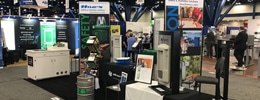Tekmar 090 Snow/ice Sensor - tekmar 090
Model 9201E AXION® Emergency Tempering Valve thermostatically mixes hot and cold water to provide a safe fluid supply for emergency showers and eyewash equipment, with a flow rate of 31 gpm (117.3 L).

Model 9201E emergency mixing valve (patent pending) thermostatically mixes hot and cold water to provide a safe fluid supply for emergency showers and eyewash equipment. Additionally, to ensure a fail-safe water supply for emergency shower and eyewash stations, a series of cold water by-pass valves open in the event of hot water pressure loss. (No gauges supplied - ASSE 1071 standard recommends gauges be placed 5 to 8 feet (1.52 to 2.44 m) downstream for the most accurate temperature measurement.) A flow rate of 1 to 31 gpm (3.8 to 117.3 L) for better temperature control across the operating range AXION's superior design and technology provide a complete safety solution for increased victim comfort. Lowest internal pressure drop for this class of valve (advantage where supply pressure is low) Wax based thermostat technology for fast response time with proven highly reliable temperature control Highest Cold Water Bypass flow rate in the industry (65% of rated tepid flow rate) Brass valve design with internal check stops Over-sized valve seats resist failures caused by foreign matter A new and efficient shuttle design eliminates valve sticking A custom funnel design improves temperature control at low flow rates Outlet temperature is factory set to 85° F (29° C). Tempered water: High temperature limit is factory set to 90° F (32° C). Cold water by-pass valves are closed during normal operation, regardless of flow rate. For important installation information, please read Scald Warning. CSA Listings: CSA certified per ASSE 1071, ANSI Z358.1, and applicable sections of CSA B125.3.
If you have a standard electric or gas tank, there are a number of things we can do to increase the amount of deliverable hot water from the simple to the complex. One of the ways to do that would be to simply increase the set-point of the thermostat so that the water stored in the tank would be hotter and would therefore go farther. For example, let’s say you crank the temperature in your tank up from 120° to 140°. It would certainly give you more deliverable hot water, but let’s take a closer look at what happens when you do that.
As for this last point, we can help safeguard against potentially hazardous conditions simply by installing a mixing valve. A mixing valve is a mechanical device that mixes cold water with hot water to deliver mixed, or tempered, water downstream (think of your shower valve). These devices can be put directly onto the water heater outlet so that the tempered water gets delivered everywhere. As another option, individual mixing valves can be installed at certain points of use to ensure that the tempered water is delivered to that specific location. Taking a look specifically at the mixing valves that install at the water heater outlet, they are relatively easy to install, adjustable and fairly inexpensive.
The ultimate in emergency response! A Free-Standing Stainless Steel Emergency Shower Certified by CSA to meet the ANSI Z358.1 standards.
More than just hydration, RIVIVE is a statement of intentional engineering design for the convenience of end-users, facility managers, specifiers, and installers.
1. The higher the temperature of the water in the tank, the faster the rate of corrosion of the tank itself. This equates to:

Prop 65 Warning. For California Residents Warning: This product contains a chemical known to the State of California to cause cancer and/or birth defects or other reproductive harm. Please click here for more information.
Mike Henry is one of Rheem’s technical trainers for plumbers. He’s a third-generation plumber who managed his own business for many years and enjoyed working in the field. He maintains Master Plumber licenses in Georgia and Florida.
May we use cookies to track your activities? We take your privacy very seriously. Please see our privacy policy for details and any questions.
Register to receive the Haws E-Newsletter, featuring Haws plumbing and safety product news, helpful articles and upcoming events.
This website uses cookies so that we can provide you with the best user experience possible. Cookie information is stored in your browser and performs functions such as recognising you when you return to our website and helping our team to understand which sections of the website you find most interesting and useful.
All in all, increasing the set-point temperature and adding a mixing valve is not a bad option for someone that’s looking to get more hot water from their tank-type water heater (without going to a larger tank or using more expensive technology).
Model 9201E (patent pending) is a thermostatic mixing valve that mixes hot and cold water to supply tempered water to emergency shower and eyewash fixtures requiring flow up to 31 gpm (117.3 L). Unit employs a paraffin filled thermostatic mixing element. Lowest internal pressure drop where supply pressure is low, and a high Cold Water Bypass flow rate of 20 gpm (75.7 L). The improved brass design with a one piece casting uses internal check stops, oversized valve seats, a shuttle design that eliminates valve sticking, and a funnel design to improve temperature control with better mixing at low flow rates. Lime and calcium resistant components are used throughout. The outlet temperature factory setting is 85° F (26° C). Maximum operating pressure: 125 psi (8.62 Bar). Temperature adjustment range 60 - 90° F (16 - 35° C). Maximum inlet temperature: 180° F (82° C). Recommended inlet temperature: 140° F (60° C). Minimum inlet temperature: 120° F (49° C) Inlets 1-1/4" NPT(F). Outlet 1-1/4" NPT(F).
Follow us on social to stay up to date on all of our useful blog content. Facebook @RheemWater Instagram @RheemWater X @Rheem_Water Plumbers’ Exchange Facebook Group for Plumbers @Plumbers.Exchange
The water heater thermostat is turned up to 140°, thus providing a tank full of 140° water. Then as water is drawn out, the mixing valve mixes cold water with that very hot water to deliver whatever temperature the homeowner chooses as their set point, which is usually 120°. This process gives the homeowner more deliverable hot water because it takes less of the stored water to produce it. They do require maintenance (cleaning) to keep them working properly. The normal lifespan for these devices is 5-6 years.
3. The higher temperature of the water in the tank, the higher the probability of someone getting burned. The time it takes to acquire a serious burn is:
One downside is that they typically fail gradually and, in doing so, tend to allow more hot water through them. Because this is gradual, the end user might not recognize the change and could be subjecting themselves to hotter-than-safe water temperatures. So, make sure to watch for that and test the water temperature periodically.
If you disable this cookie, we will not be able to save your preferences. This means that every time you visit this website you will need to enable or disable cookies again.
By submitting this form, you agree to opt-in and receive communications from Rheem. In connection with your providing me with your personal information, we must advise you that information about Rheem’s practices regarding your personal information is located in Rheem's Privacy Notice located here.




 8615510865705
8615510865705 
 8615510865705
8615510865705